In August last year in Climate clippings 181 (Item 5) I linked to a report by Climate Analytics examining the impacts on Australia of limiting global temperature rise to 1.5°C and 2°C.
For me the crux of the report is this, from a discussion piece at The Conversation:
- The report predicts that half of the world’s identified tipping points – such as the collapse of polar ice sheets and the drying out of the Amazon rainforest – would be crossed under 2C warming, compared with 20% of them at 1.5℃.
If we go to 2℃, we will have a very different climate and there is a good chance we won’t be able to stabilise there. The bad news is that if we just carry on we’ll reach 1.5C by 2024, and 2C by 2036.
What the report is telling us, says Giles Parkinson, is that if we don’t update our 2030 targets, we’ll have just a further five years at that point to reach zero emissions. That is, by 2035.
The Climate Institute, which commissioned the report, said Australia:
- needs to have half of its electricity sourced from renewable energy by 2030, and to have coal-fired generation completely phased out by 2035.
In the same issue of Climate clippings I reported on a study by John Fasullo and colleagues predicting that satellites will detect accelerating sea level rise within the next decade.
Satellites have provided super accurate measurements of sea level rise only since 1993. However, specially designed climate model simulations showed the 1991 eruption of Mt Pinatubo is likely to have masked the acceleration that would have otherwise occurred.
It’s too early to definitely identify a trend, but more scientists are coming to the view long espoused by James Hansen that ice sheet decay is likely to proceed geometrically once it gets going, which could give us multi-metre sea level rise this century. This illustrates how things could pick up rapidly late in the century:
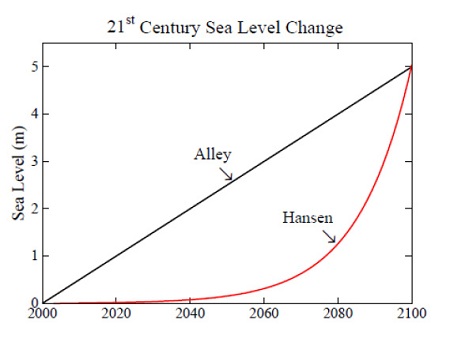
My most recent post on the topic was Ice sheet decay spells danger from sea level rise.
Going back to the Climate Analytics report, the models used did not incorporate longer term effects of CO2 increase. I dealt with this issue in the post Reconciling estimates of climate sensitivity. We need to distinguish between TCR (transient climate response), the effect over the first 70 years, and ECS (equilibrium climate response), the effect over centuries. When this is considered the effect of doubling CO2 is more likely to result in a temperature rise of 6°C rather than 3°C, but that might play out over the centuries.
If you look at the Keeling curve since about 1700, you get this:
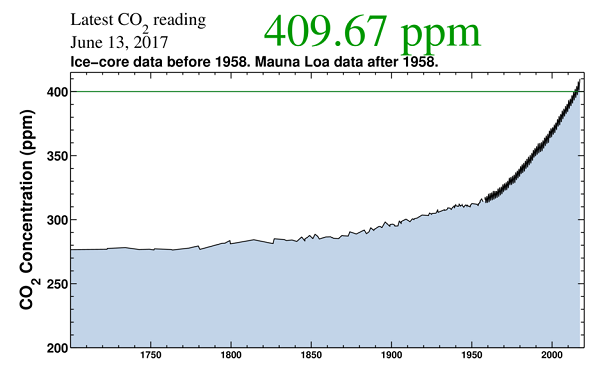
Clearly CO2 emissions took off around 1950. The first notions of climate sensitivity were couched in terms of the so-called ‘Charney feedbacks’, which meant fast feedbacks in the first 30 years, after a report chaired by Jule Gregory Charney in 1979. Much subsequent work on climate sensitivity and climate prediction is based on this foundation. Unfortunately it has limited the parameters of how scientists conceptualise the task before us right up until the latest IPCC report.
James Hansen took a broader view, drawing in evidence from the paleo record. This broader view would have been part of his thinking when, in response to a question put to him by Bill McKibben, Hansen stated that we should be aiming at 350 ppm for a safe climate. On the basis of that answer McKibben founded 350.org. Hansen’s statement was delivered in December 2007, in a meeting he held associated with the annual American Geophysical Union Conference, as the UNFCCC was meeting in Bali, with Australia’s newly elected Rudd government represented by Penny Wong.
Hansen formalised his findings on climate sensitivity in a 2011 paper. Unfortunately it will take about 10 years for the mainstream published science to catch up.
However, the idea of a ‘climate budget’ has entered the discourse, that is, the amount of CO2 we can still emit to meet climate targets. Problem is these budgets are largely based on the restricted thinking of Charney climate sensitivity, whereas the Keeling graph suggests that longer term effects should be kicking in, if they haven’t already.
David Spratt is a science writer, who actually called for a 320 ppm target in an online article with Philip Sutton called The Big Melt, in 2007, before the Hansen statement. That article later evolved into the book Climate Code Red, which you can find at the blog site of the same name. He has been diligent in following research that takes in the whole picture, and is not limited by restrictive models.
So a signal event for me was when he blew the whistle, and said, actually there is no burnable carbon left, we’ve blown the budget. I reported this in the June 2014 post The game is up as follows:
David Spratt now tells it straight:
- We have to come to terms with two key facts: practically speaking, there is no longer a “carbon budget” for burning fossil fuels while still achieving a two-degree Celsius (2°C) future; and the 2°C cap is now known to be dangerously too high.(My bold)
I try to add all my posts on dangerous climate change to a list I compiled at the end of a post The folly of two degrees, which can always be found at Key posts on the left side-bar of the blog. It includes Is 1.5°C attainable?
Politically I fear it is not, and in the real world, not without overshoot.
Back to the Climate Analytics report, it says that with current Paris Agreement commitments the planet on a path to 3°C or close to 4°C, which for reasons outlined above probably means double that, in the course of time.
Also:
- The first review, or stock take, of the aggregate effect of all INDC commitments that countries have put forward in relation to the 1.5°C limit in the Paris Agreement and the long-term global emission goals will occur in 2018 as part of facilitative dialogue agreed in Paris. The 2018 facilitative dialogue process will be informed by a specifically requested IPCC Special Report on 1.5°C impacts and on how to close the gap between current policies, NDCs and emission pathways consistent with the Paris Agreement in 2025 and 2030. Based on this, by 2020 at the latest governments need to submit updated NDCs for 2025 and 2030 that effectively close this gap. There is therefore an expectation that Australia improves its emission reductions pledge to be consistent with the Paris Agreement and its enabling decisions.
We have to worry whether the IPCC is keeping up with the likes of James Hansen. However, Australia’s commitments, which were more than “aspirational” as Abbott asserts, were pathetically inadequate even in relation to the present inadequate Paris commitments by other countries.
Time to get the head out of the sand:

Remember too, as Roger Jones keeps reminding us, climate change tends not to happen in an orderly linear way and may surprise with sudden changes. The effects of tipping points upon tipping points make short-term climate predictions fraught with risk. A safe climate is what we want. Arguably what we’ve got is already dangerous.
Update: The notion that some scientists are saying that we can still avoid 1.5°C while continuing to burn carbon, and reach zero global emissions as late as 2050 or even 2070, seems on the face of it absurd. Have a look at this NASA Gistemp temperature graph:
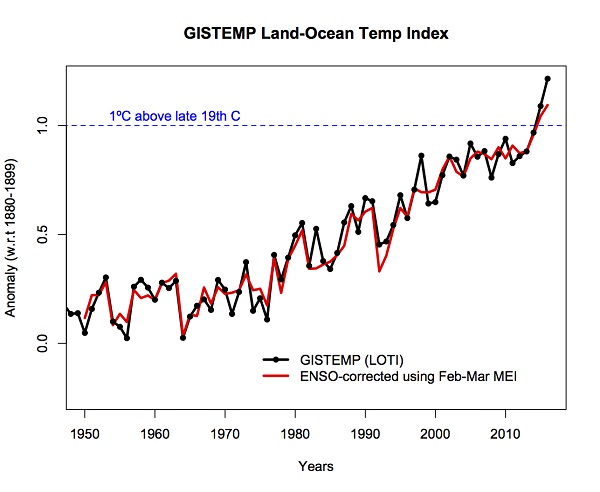
Here’s Hansen’s graph with a 132-month running average:
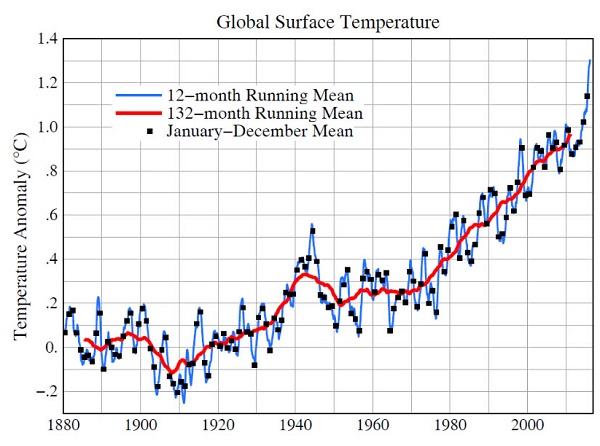
Another recent study, by Henley and King, has found that 1.5°C could be reached by 2026 or 2031 depending on whether the Interdecadal Pacific Oscillation (IPO) is negative or positive. (See also New Scientist.)
Consider also this graph from Hansen which shows trends in sea level rise:
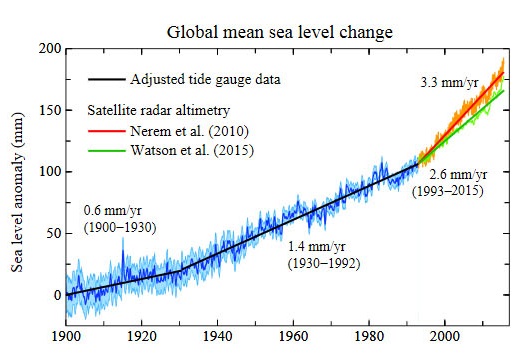


Then we have the current debate around the Finkel report.
The irony is that the best thing that could happen to the world economy would for war to be declared on climate change.
And maybe ease up a little on nuclear for a bit, or is that temporary compromise out of the question ?
Jumpy, nukes would be too expensive in Australia, so they are not really a solution. I think the Chinese are building some, but I haven’t sees a report or article for a while.
I’ve been thinking about the notion that some scientists are saying that we can still avoid 1.5°C while continuing to burn carbon, and reach zero global emissions as late as 2050. Have a look at this NASA Gistemp temperature graph:
Here’s Hansen’s graph with a 132-month running average:
And this graph from Hansen shows trends in sea level rise:
Another recent study, by Henley and King, has found that 1.5°C could be reached by 2026 or 2031 depending on whether the Interdecadal Pacific Oscillation (IPO) is negative or positive.
I’ve put an update on the end of the post containing the information in the last couple of comments.